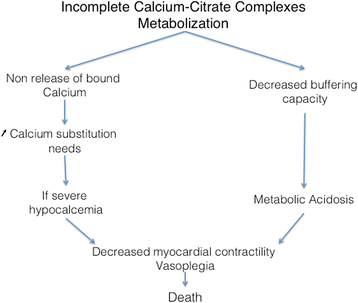Complications of regional citrate anticoagulation: accumulation or overload?
- PMID: 29151020
- PMCID: PMC5694623
- DOI: 10.1186/s13054-017-1880-1
Complications of regional citrate anticoagulation: accumulation or overload?
Abstract
Regional citrate anticoagulation (RCA) is now recommended over systemic heparin for continuous renal replacement therapy in patients without contraindications. Its use is likely to increase throughout the world. However, in the absence of citrate blood level monitoring, the diagnosis of citrate accumulation, the most feared complication of RCA, remains relatively complex. It is therefore commonly mistaken with other conditions. This review aims at providing clarifications on RCA-associated acid-base disturbances and their management at the bedside. In particular, the authors wish to propose a clear distinction between citrate accumulation and net citrate overload.
Keywords: Acute kidney injury; Citrate accumulation; Complications of therapy; Continuous renal replacement therapy; Metabolic alkalosis; Regional citrate anticoagulation.
Conflict of interest statement
Ethics approval and consent to participate
Not applicable.
Consent for publication
Not applicable.
Competing interests
AS received speaker honoraria from Fresenius Medical Care and Baxter Healthcare Corp. and consulting honoraria from B. Braun Melsungen AG. DJ has no competing interests to disclose. TR received speaker honoraria from Fresenius Medical Care, Baxter Healthcare Corp., and Bellco-Medtronic.
Publisher’s Note
Springer Nature remains neutral with regard to jurisdictional claims in published maps and institutional affiliations.
Figures





References
-
- Uchino S, Bellomo R, Morimatsu H, Morgera S, Schetz M, Tan I, Bouman C, Macedo E, Gibney N, Tolwani A, et al. Continuous renal replacement therapy: a worldwide practice survey. The beginning and ending supportive therapy for the kidney (B.E.S.T. kidney) investigators. Intensive Care Med. 2007;33(9):1563–70. doi: 10.1007/s00134-007-0754-4. - DOI - PubMed
-
- Stucker F, Ponte B, Tataw J, Martin PY, Wozniak H, Pugin J, Saudan P. Efficacy and safety of citrate-based anticoagulation compared to heparin in patients with acute kidney injury requiring continuous renal replacement therapy: a randomized controlled trial. Crit Care. 2015;19:91. doi: 10.1186/s13054-015-0822-z. - DOI - PMC - PubMed
-
- Gattas DJ, Rajbhandari D, Bradford C, Buhr H, Lo S, Bellomo R. A randomized controlled trial of regional citrate versus regional heparin anticoagulation for continuous renal replacement therapy in critically ill adults. Crit Care Med. 2015;43(8):1622–9. doi: 10.1097/CCM.0000000000001004. - DOI - PubMed
MeSH terms
Substances
LinkOut - more resources
Full Text Sources
Other Literature Sources
Medical

